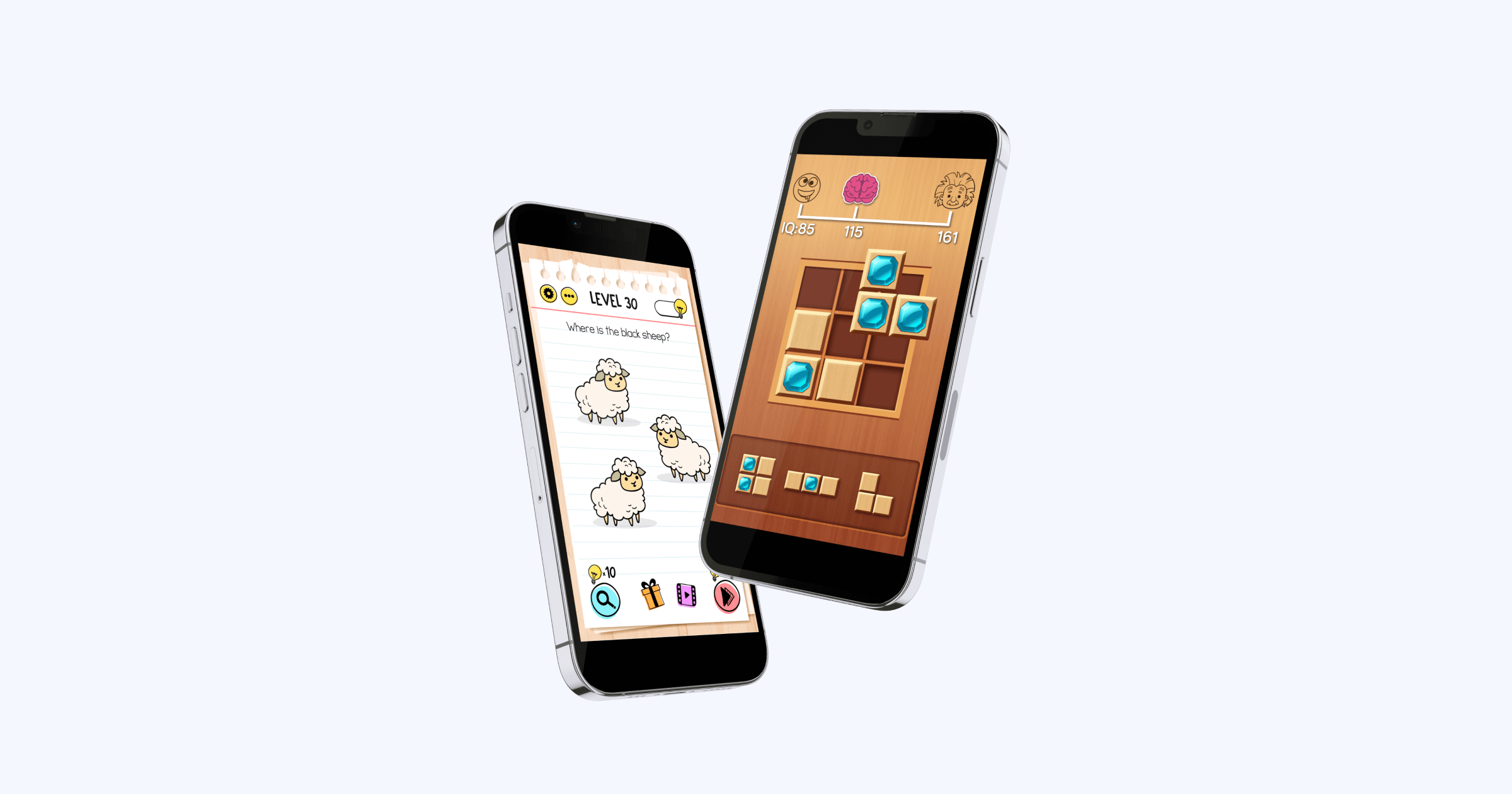The Chinese mobile games market is huge and lucrative, but many game devs are perplexed by it. Breaking into this market is not a simple task, but it’s certainly achievable with the right strategy and approach.
Want to unlock the secrets of the Chinese mobile games market?
You’ve come to the right place.
In this article, we will cover everything you need to know about the world’s biggest mobile games market, including its:
- Size and scope
- Gaming regulations
- Top genres
- Player preferences
Let’s dive right in!
How Big Is the Mobile Gaming Market in China?
China accounts for a whopping 1/3 of the global mobile games market. Not only that, but this market keeps on growing in terms of both player count and revenues.
At the moment, China is home to 660 million mobile gamers (Statista). This number has more than doubled over the past decade, rising from 310 million players in 2013.
With so many players comes great power and of course, great revenues.
According to the latest estimations, the Chinese mobile gaming market is worth $34.1 billion (Niko Partners).
Furthermore, mobile gaming dominates PC and console gaming, capturing a significant 74% portion of the total game market, which is worth approximately $45.8 billion (Newzoo).
About Chinese Gaming Regulations
Given its size and scope, the Chinese mobile games market undoubtedly deserves the attention of each game developer in the world.
But, it comes with a catch.
China has strict gaming regulations that pose a major challenge for mobile gaming companies. Not only that, but Chinese players have a distinct set of habits and preferences developers need to be aware of.
Because of this, many studios shy away from this market and focus their efforts elsewhere.
But, the companies that take on the challenge of developing games that comply with the rules and preferences stand a great chance of succeeding in this major market.
Want to become one of them?
Here is a list of Chinese gaming regulations you need to be aware of.
Game Licenses
To get published in China, all games with payment features (IAPs or Premium), need to obtain a special license.
This license is issued by the country’s National Press and Publication Administration (NPPA). To get your game approved, you need to follow different rules set by NPPA. Among other things, this means that your games are not allowed to:
- Promote gambling or extreme violence
- Violate others’ copyrights
- Contain opposing views on the People’s Republic of China’s Constitution
- Put social morality or national cultural traditions at risk
- Promote cults and superstitions, etc.
On the other hand, the regulatory body encourages games with educational elements, those that match the government’s social values, historical views, etc.
How Many Games Get Approved in China?

Due to these strict licensing rules, it’s not surprising that the majority of games that get the license are domestic titles.
Let’s go over the numbers.
The record year for game licensing was 2017, when NPPA issued 9,177 licenses for domestic game developers and 456 for foreign ones. After that, the regulations were further tightened, which significantly lowered the number of issued licenses.
In 2021/2022 things got even more complicated – China introduced a freeze on new game licenses.
The freeze lasted for almost nine months, leading to a record-low game license count in 2022. That year, the body issued only 512 licenses, 91% of which were Chinese titles (Niko Partners & NPPA).
A Positive Trend
Once the freeze was lifted, the Chinese game market got back on track.
In Q1 2023 alone, NPPA approved 288 games. If this rate of approval continues, we can expect 1100 new licenses to be issued by the end of the year.
True, this is still far from the pre-2018 levels.
Nevertheless, the trend is clearly positive and creates an encouraging atmosphere for foreign game developers looking to publish their games in China.
Partnering with A Local Publisher
To get a game published in China, it’s not enough “just” to follow NPPA’s content rules. Another necessary requirement is to partner with a domestic publisher.
The thing is, only companies with 100% Chinese ownership are eligible for a game license.
However, this still doesn’t place them in the category of domestic publishers.
Even if you manage to get your game published by working with a trusted Chinese publisher, it would still be classified as imported.
For example, in China, both Call of Duty: Mobile and FIFA are published by Tencent. But, because their original IPs are foreign, they are considered imported games.
Does it matter which local publisher you work with?
Well, yes.
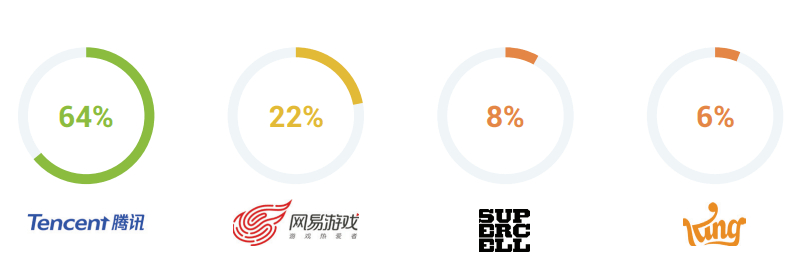
When picking out a local publisher to work with, aim for the big ones like Tencent and NetEase. According to Mintegral, 86% of Chinese players prefer these two publishers over all the others. Working with them is especially helpful for user acquisition, as players are more likely to install a game from a trusted advertiser.
The Exception
If you want to publish a game that monetizes with ads only, you don’t need an NPPA license.
At least for now.
But, there are other hurdles you’ll need to overcome.
You’ll still need a Chinese publisher to release your game. Plus, be warned that the Chinese government has started closely monitoring ad-monetized games. In June 2022, three games were banned from the app stores for not having game licenses, and all of their profits were seized (Newzoo).
This implies that, in the future, ad-based games will likely also need licenses to get on the Chinese mobile games market.
Regulations for Children

Besides game content, China also regulates the amount of time minors can spend playing games.
These restrictions were introduced in 2021 with the goal of protecting children from gaming addiction and overspending.
Here are some of the rules Chinese underage gamers need to follow:
- Children and minors are only allowed to play games on Fridays, weekends, and holidays from 8 to 9 PM
- Kids from ages 8 to 16 can spend up to $30 per month on games
- Teenagers aged 16 to 18 can spend up to $60 per month on games
How do games detect minors?
All gaming companies are required to identify anyone under the age of 18. In order to play any game, players need to submit their IDs.
Top App Stores
In China, 75.4% of people use Android devices (Statista).
But, they can’t download games from the Google Play Store because it’s banned in the country. Apple, on the other hand, has a special version of its App Store for iPhone users.
This naturally makes you wonder – where do Chinese people download apps & games?
In a lot of cases, they use the app stores developed by their device manufacturers. The leading five app stores in China by market share are the Huawei App Market Store, Oppo Software Store, VIVO App Store, Tencent My App Store, and MIUI App Store (AppInChina).
Chinese Mobile Games Market: Top Genres & Games
What types of genres and subgenres rule the Chinese mobile games market? Which titles are on top of the charts?
Here come the answers.
Most Popular Genres
Mobile gamers worldwide share some common traits, but their preferences can significantly vary by region.
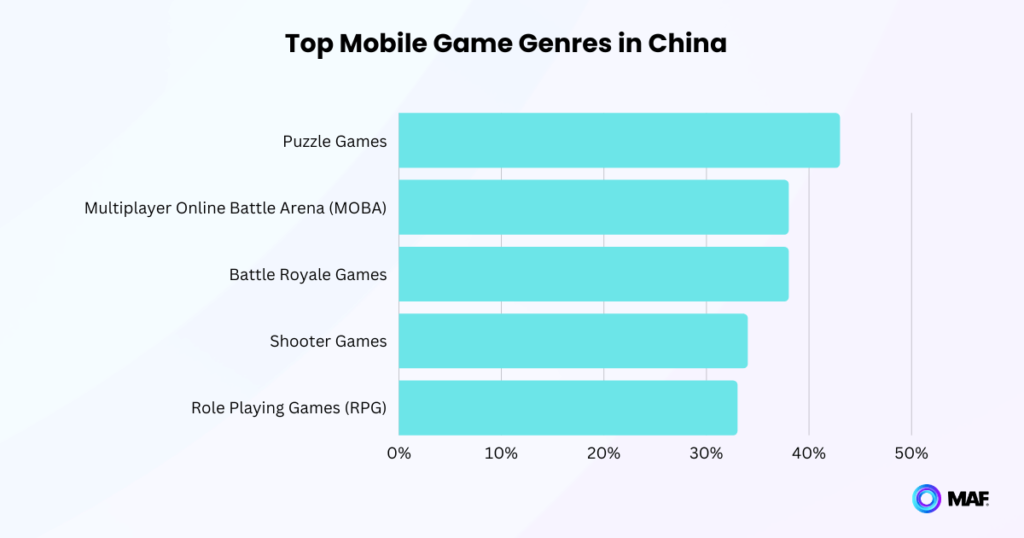
For example, while US players play hyper-casual and simulation games the most, according to Mintegral, Chinese gamers’ favorite genres are:
- Puzzle games (43%)
- MOBA games (38%)
- Battle Royale games (38%)
- Shooter games (34%)
- RPG games (33%)
Since each genre contains different types of games, it’s also beneficial to know which subgenres Chinese players like. Some of their favorites are MMORPG (Massive Multiplayer Online Role Playing Games), RTS (Real-time Strategy), and Open-world RPG.
You might be wondering how these typically violent game genres manage to get away with in-game violence.
The truth is, the rules on this matter are not as strict as they appear.
For example, displaying a character’s death is acceptable as long as there is no bloodshed. It is recommended that deceased bodies vanish quickly, for instance, by gradually fading away.
Top-Grossing Games
While puzzle games may lead the download charts, when it comes to revenue, mid-core games hold the throne.
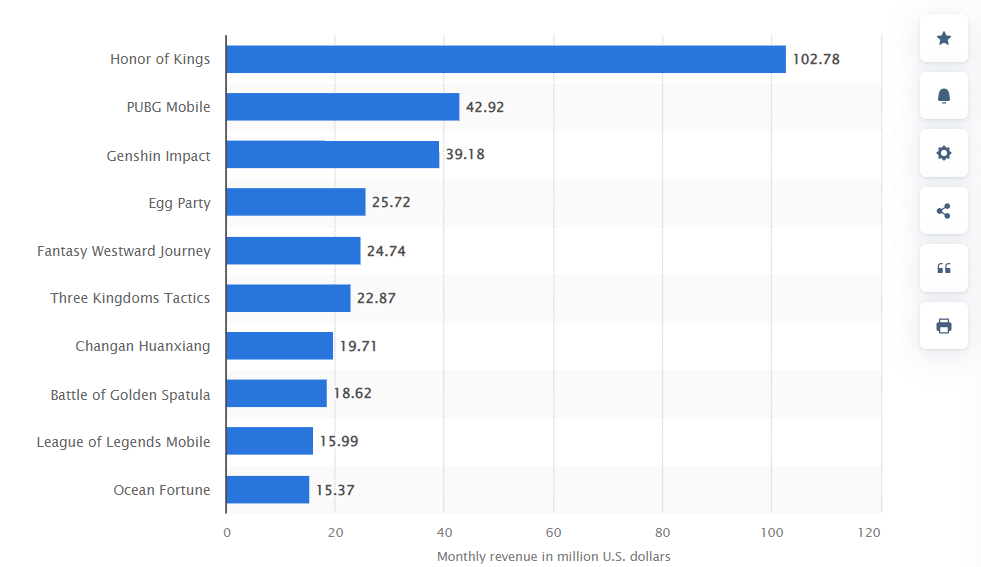
Currently, the three top-grossing games in the Chinese mobile games market are:
- Honor of Kings (Tencent Games)
- PUBG Mobile (Tencent Games)
- Genshin Impact (miHoYo)
With over $100 million in monthly revenue, Honor of Kings is practically a cultural phenomenon in China. This MOBA title has been sitting at the top of the Chinese revenue charts for years.
Although its gameplay mechanics resemble League of Legends (LoL), this game gained an early advantage by going mobile in 2015, while LoL didn’t introduce its mobile version until 2020.
Chinese Mobile Gamers: Key Characteristics
Because of their distinctive characteristics, you can’t approach Chinese mobile gamers the same way you do in the West.
Here are the top things you should know about them.
Demographics & Habits
The age/gender split of Chinese mobile gamers is similar to that of the rest of the world.
Just like globally, the majority of Chinese mobile game players (55%) are male. Also, most of them are Gen Z or Millennials, falling into the 21-35 age bracket (Mintegral).
However, when it comes to playing habits, there are some significant differences.
Every day, 52% of mobile gamers in China clock in over 1 hour of gameplay which is approx. 15 minutes more than the world average.
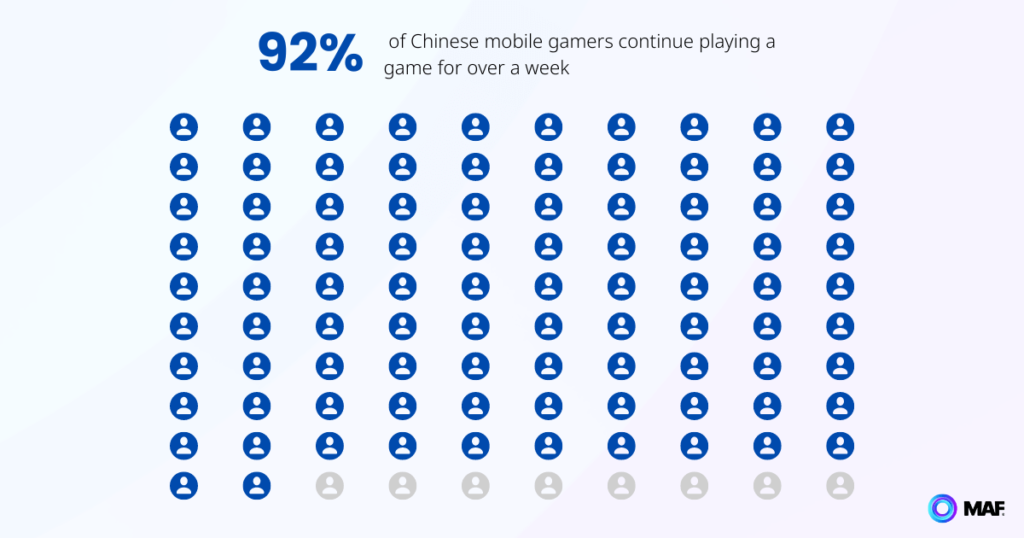
Additionally, Chinese players don’t abandon games as quickly as the average player – 92% of them say they continue playing a game for over a week (Mintegral). This is likely linked to the fact that they prefer engaging casual and mid-core games, rather than short-lived hyper-casual titles.
Preferences
Chinese mobile gamers have some interesting attitudes toward discovering new games, ads, and in-game spending. Here are just some of them, according to Mintegral:
- The two main ways Chinese players discover new titles are app store rankings (36%) and recommendations from friends and family (29%)
- They prefer free-to-play games with in-app purchases (44%) over premium and ad-funded games
- Only 15% of Chinese mobile gamers don’t spend anything on mobile games, with the majority of them spending up to $5.80 per month
- Their preferred ad types are rewarded ads (27%) and native in-game ads (22%)
Tips for Developing Games for the Chinese Mobile Games Market
Despite all obstacles, you’re up to the challenge of developing a game for the Chinese mobile games market?
That’s the spirit!
Besides a positive spirit, you’ll also need a lot of patience and knowledge. We can’t help with the first two but we can help by sharing some tips for creating successful games for the Chinese mobile games market.
1. Include PvP Gameplay

When asked what motivates them to play mobile games the most, 36% of Chinese players said competitiveness (Mintegral).
They even prioritize competition over game quality, so you know just how important a role it plays.
This is supported by the fact that almost all games on the Chinese top-grossing charts include some kind of PvP gameplay. Therefore, if you want to increase your chances of climbing the top charts, make sure to introduce a competitive mode.
2. Consider Partnering With Big IPs
We know, getting signed by a big IP is a challenge of its own.
However, joining forces with a renowned IP can work wonders for your game’s success in the Chinese mobile games market.
Need proof?
In 2022, seven out of the top ten highest-grossing imported mobile games in China were based on popular IPs (Newzoo).
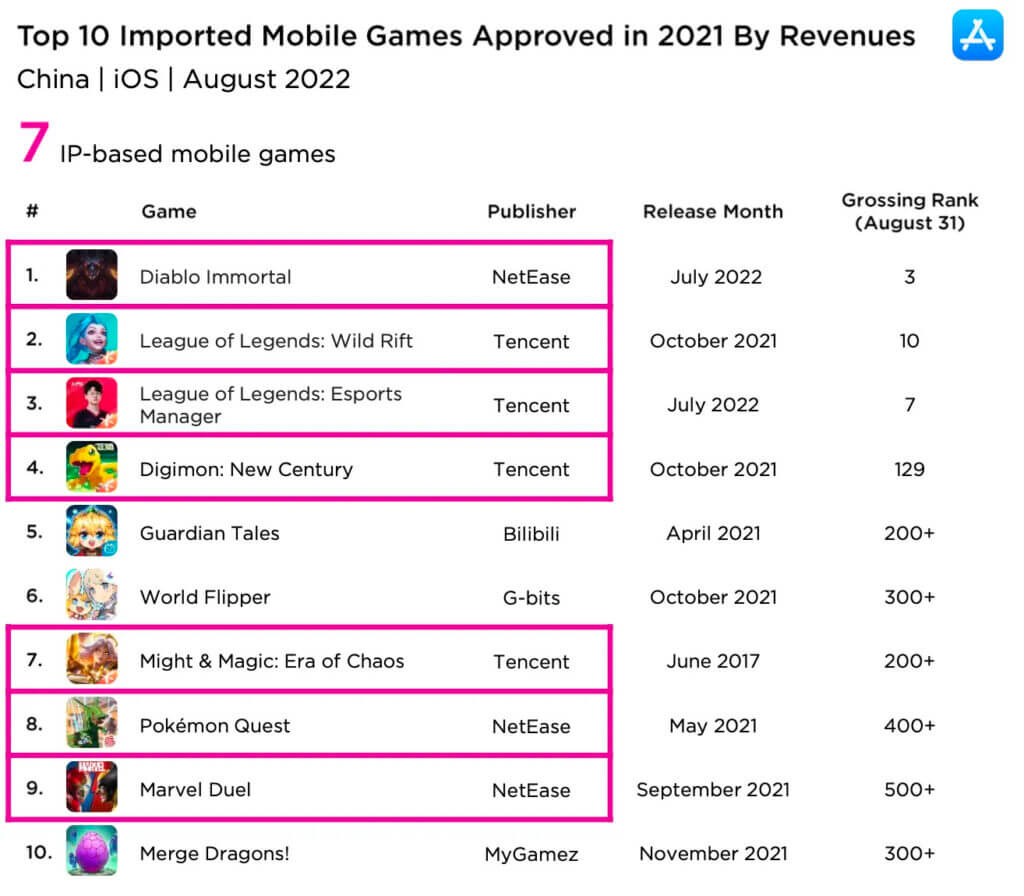
Such games resonate with the Chinese player base because they are widely popular and recognizable. Almost everyone in China is familiar with franchises like Diablo Immortal, League of Legends, Pokémon, and Digimon.
3. Localize
Chinese players love localized mobile games.
Localization is not just about translating text – it is about adding a cultural touch to the entire gaming experience. This is a process that includes activities like:
- Researching cultural preferences
- Optimizing user interfaces
- Updating themes based on local holidays, etc.
According to Mintegral’s research, 32% of Chinese players prefer games that include Chinese design and themes. To cater to this, many of the top games in China include storylines and characters from Chinese history and literature.
Sounds like too much of a hassle?
If you partner with popular IPs, you can minimize the need for localization. Since these games are already based on well-known franchises, Chinese players are more likely to accept them in a less localized version.
Chinese Mobile Games Market: Parting Words
Hopefully, this article helped you better understand how the Chinese mobile games market works.
Want to read more insightful articles like this one? Subscribe to our newsletter and always stay up to date on the world of mobile games!



